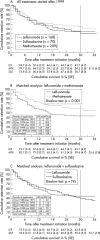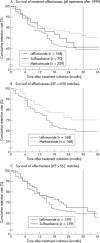Survival and effectiveness of leflunomide compared with methotrexate and sulfasalazine in rheumatoid arthritis: a matched observational study
- PMID: 12972472
- PMCID: PMC1754333
- DOI: 10.1136/ard.62.10.944
Survival and effectiveness of leflunomide compared with methotrexate and sulfasalazine in rheumatoid arthritis: a matched observational study
Abstract
Objective: To determine the survival and clinical effectiveness of leflunomide (LEF) compared with methotrexate (MTX) and sulfasalazine (SSZ) for RA in an observational study.
Methods: An observational database of 1088 patients and 5141 patient years of DMARD treatment (2680 courses) from two academic hospitals was filtered for treatment with LEF, MTX, and SSZ. LEF treatment groups were matched for patients' age, baseline ESR, number of previous DMARDs, and hospital cohort with MTX and SSZ treatment groups. For these treatments, Kaplan-Meier analyses of time until the drug was discontinued (drug "survival"), and the effectiveness and safety of continuation of treatment, were performed. The change in disease activity markers (CRP, ESR) was compared between the groups.
Results: The median dose during the study increased from 10 to 15 mg MTX/week and from 1.5 to 2.0 g SSZ/day. Matched survival analysis showed better retention rates for MTX (mean (SEM) survival 28 (1) months) than for LEF (20 (1) months; p=0.001), whereas retention rates of SSZ (23 (1) months) were similar to those of LEF (p=NS). Treatments were stopped earlier because of adverse events (AEs, 3 months) than because of ineffectiveness (IE, 10 months; p<0.001). LEF and MTX were less likely to be stopped because of AEs than SSZ. LEF courses were stopped earlier for AEs (p<0.001) than MTX.
Conclusions: Current dosing strategies should be re-evaluated, and coping strategies for common AEs should be investigated. This will be necessary to achieve better drug retention of LEF. At present, MTX continues to be the most effective drug in clinical practice.
Figures





Similar articles
-
Step-up combination versus switching of non-biological disease-modifying antirheumatic drugs in rheumatoid arthritis: results from a retrospective observational study.Ann Rheum Dis. 2007 Aug;66(8):1059-65. doi: 10.1136/ard.2006.061820. Epub 2007 Feb 16. Ann Rheum Dis. 2007. PMID: 17307765 Free PMC article.
-
Treatment with leflunomide slows radiographic progression of rheumatoid arthritis: results from three randomized controlled trials of leflunomide in patients with active rheumatoid arthritis. Leflunomide Rheumatoid Arthritis Investigators Group.Arthritis Rheum. 2000 Mar;43(3):495-505. doi: 10.1002/1529-0131(200003)43:3<495::AID-ANR4>3.0.CO;2-U. Arthritis Rheum. 2000. PMID: 10728741 Clinical Trial.
-
Long-term efficacy of leflunomide on disease activity and inhibition of joint damage: retrospective comparison with methotrexate for Japanese rheumatoid arthritis patients.Mod Rheumatol. 2009;19(5):513-21. doi: 10.1007/s10165-009-0201-1. Epub 2009 Jul 15. Mod Rheumatol. 2009. PMID: 19603251
-
Leflunomide in monotherapy of rheumatoid arthritis: meta-analysis of randomized trials.Pol Arch Med Wewn. 2012;122(1-2):22-32. doi: 10.20452/pamw.1131. Epub 2012 Jan 11. Pol Arch Med Wewn. 2012. PMID: 22353705 Review.
-
Benefit-risk assessment of leflunomide: an appraisal of leflunomide in rheumatoid arthritis 10 years after licensing.Drug Saf. 2009;32(12):1123-34. doi: 10.2165/11316650-000000000-00000. Drug Saf. 2009. PMID: 19916579 Review.
Cited by
-
Step-up combination versus switching of non-biological disease-modifying antirheumatic drugs in rheumatoid arthritis: results from a retrospective observational study.Ann Rheum Dis. 2007 Aug;66(8):1059-65. doi: 10.1136/ard.2006.061820. Epub 2007 Feb 16. Ann Rheum Dis. 2007. PMID: 17307765 Free PMC article.
-
Immunomodulatory properties of a methanolic extract of Ficus lyrata mitigate inflammation in Complete Freund's Adjuvant-induced arthritis.Inflammopharmacology. 2025 Apr;33(4):1921-1934. doi: 10.1007/s10787-025-01700-6. Epub 2025 Mar 26. Inflammopharmacology. 2025. PMID: 40140117
-
Therapeutic drug monitoring of A77 1726, the active metabolite of leflunomide: serum concentrations predict response to treatment in patients with rheumatoid arthritis.Ann Rheum Dis. 2005 Apr;64(4):569-74. doi: 10.1136/ard.2004.025205. Epub 2004 Sep 2. Ann Rheum Dis. 2005. PMID: 15345501 Free PMC article.
-
Sulphasalazine inhibits human antigen-specific immune responses in vivo.Ann Rheum Dis. 2007 Apr;66(4):481-5. doi: 10.1136/ard.2006.059881. Epub 2006 Sep 19. Ann Rheum Dis. 2007. PMID: 16984937 Free PMC article. Clinical Trial.
-
Reappraisal of the clinical use of leflunomide in rheumatoid arthritis and psoriatic arthritis.Open Access Rheumatol. 2010 Nov 3;2:53-71. doi: 10.2147/OARRR.S9448. eCollection 2010. Open Access Rheumatol. 2010. PMID: 27789998 Free PMC article. Review.
References
Publication types
MeSH terms
Substances
LinkOut - more resources
Full Text Sources
Medical
Research Materials
Miscellaneous

